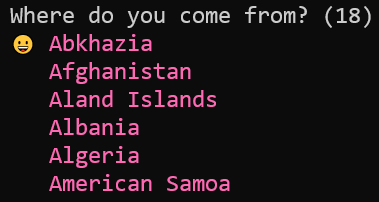Simple Node.js CLI library to display a list of scrollable choices and ask user for selection.
Ask is a Node.js module that offers an easy-to-use API to display a list of scrollable choices. The end user navigates the choices with the up arrow and down arrow keys and presses the Enter key for selection. Configurable options are shown below:
- 8-bit and 24-bit text terminal colors.
- Number of visible rows in the scrollable window.
- Selection pointer can be specified with a UTF-8 string.
- The file
ask.jsrequires Node.js >= 14.0.0 due to usage of the optional chaining operator (?.) from ES2020. - The file
ask.jshas zero external dependencies.
Here is a complete working program to demonstrate how to use the ask module.
Call the ask function with an array of strings followed by an options object.
The ask function returns a Promise that resolves to an integer indicating
the zero-based answer.
'use strict'
const ask = require('./ask')
async function main() {
const choices = [
'Abkhazia',
'Afghanistan',
'Aland Islands',
'Albania',
'Algeria',
'American Samoa',
'Andorra',
'Angola',
'Anguilla',
'Antarctica',
'Antigua and Barbuda',
'Argentina',
'Armenia',
'Aruba',
'Ascension',
'Australia',
'Austria',
'Azerbaijan',
]
console.log(`Where do you come from? (${choices.length})`)
const answer = await ask(choices, { color: 'HotPink', maxWindow: 6, pointer: '😀' })
console.log(choices[answer])
}
main()
Running the above program produces the output shown below. Note that we specified
maxWindow: 6 but there are 18 choices, so scrolling is possible. Use the up arrow
and down arrow keys to move the selection pointer. Press Enter to confirm selection,
and CTRL-C to terminate the program immediately.
The ask function can also be called without passing in the options argument.
Type npm start on the command line for a simple demo.
Text terminal colors are displayed using
ANSI escape codes that were introduced in the 1970s.
However, the ask function hides all the details from the developer and hence colors may be
specified using:
- A
Numbertype (8-bit indexed color; e.g.{ color: 6 }for cyan), or - A
Stringtype (24-bit RGB color; see below for details)
For 8-bit color, refer to the 256-color lookup table on Wikipedia.
For 24-bit color, CSS named-colors, hex-colors, rgb-colors and hsl-colors are supported
via the file css-colors.js. Examples are shown below:
{ color: 'CornflowerBlue' }{ color: '#fe10ca' },{ color: '#d2b' }{ color: 'rgb(188,0,95)' },{ color: 'rgb(0%,50%,100%)' }{ color: 'hsl(0,100%,50%)' }
Below are a list of usage notes for 24-bit color string values:
- All color values are case-insensitive.
- Spaces should not be used within the color values.
- Alpha values are not supported.
- Invalid color values are silently ignored.
- A list of CSS color names can be found on w3schools.com and MDN.
The file css-colors.js must be present if you want 24-bit color support. That file may be removed if
you are fine with 8-bit color or whatever color your text terminal was already set up to display.
- Steve Leong - Initial work
This project is licensed under the MIT License - see the LICENSE file for details.
